Businesses deal with a ton of data every day. They use data to identify inefficiencies, opportunities, and more. However, when aggregated, data is raw and meaningless. It is insight from aggregated data that is meaningful to organizations.
A data analyst turns raw data into valuable insights that businesses need to make critical decisions.
However, hiring a data analyst is not a walk in the park. If you get it right, your data become great assets helping you make sound business decisions. But, if you get it wrong, your data will be anything but an asset.
This article will help you get it right when hiring a data analyst. It’s a detailed “how to hire data analyst” guide that treats:
- Identifying who you exactly need
- Data analyst hiring process
- How to get the best out of your data analyst.
Identifying who you exactly need
The recipe for failure is putting “a square peg in a round hole.” So, the first step to hiring the first data analyst is identifying who you exactly need.
You need someone who fits into your organization’s needs and direction. The main discussion is whether the data analyst is required for a one-off project or on an ongoing basis. This will determine whether you should hire a part-time or full-time data analyst.
A part-time analyst will serve you if your needs include developing a particular model or analyzing a specific data set. But if your needs are making sense of a continuous inflow of datasets, you should hire a full-time data analyst.
When to hire a data analyst

Source: thinkgrowth.org
Your business starts dealing with data from day one. However, you don’t need a data analyst from those foundational days.
Data analysts command good salaries, and the limited resources you’ll have when starting your business should not go into hiring a data analyst. Also, this is the stage where you’ll be closest to your business, so you should be able to make good decisions based on your instincts.
Hiring a data analyst may also not be efficient even when your business has grown to 10 – 20 employees. You’re still not big enough to justify investing in building data infrastructure and hiring a data analyst. Instead, hire workers who can use the built-in reporting capabilities of your SaaS products.
When you’ve grown to 20 – 50 employees, you should bring a data analyst on board. With data coming from everywhere, you need a central team to make sense of them. First, you need to build your data infrastructure and then hire an analyst lead.
What to expect from your first data hire
Your first data analyst hire should be someone who is a merger of a data analyst and analytics engineer.
This is because when making your first hire, you’ll either not have a data infrastructure or will be in the process of building one. So, you need someone who’ll evaluate data to report on the state of business and build some of the foundations of the data warehouse.
What your first data analyst hire will do
Your first hire will do the following:
- Data Analysis
- Investigate trends
- Do ad-hoc analysis
- Build simple dashboards to display and analyze data
- Report on the state of the business
- Analytics Engineering
- Own the data warehouse
- Develop data models that’ll be used for analysis
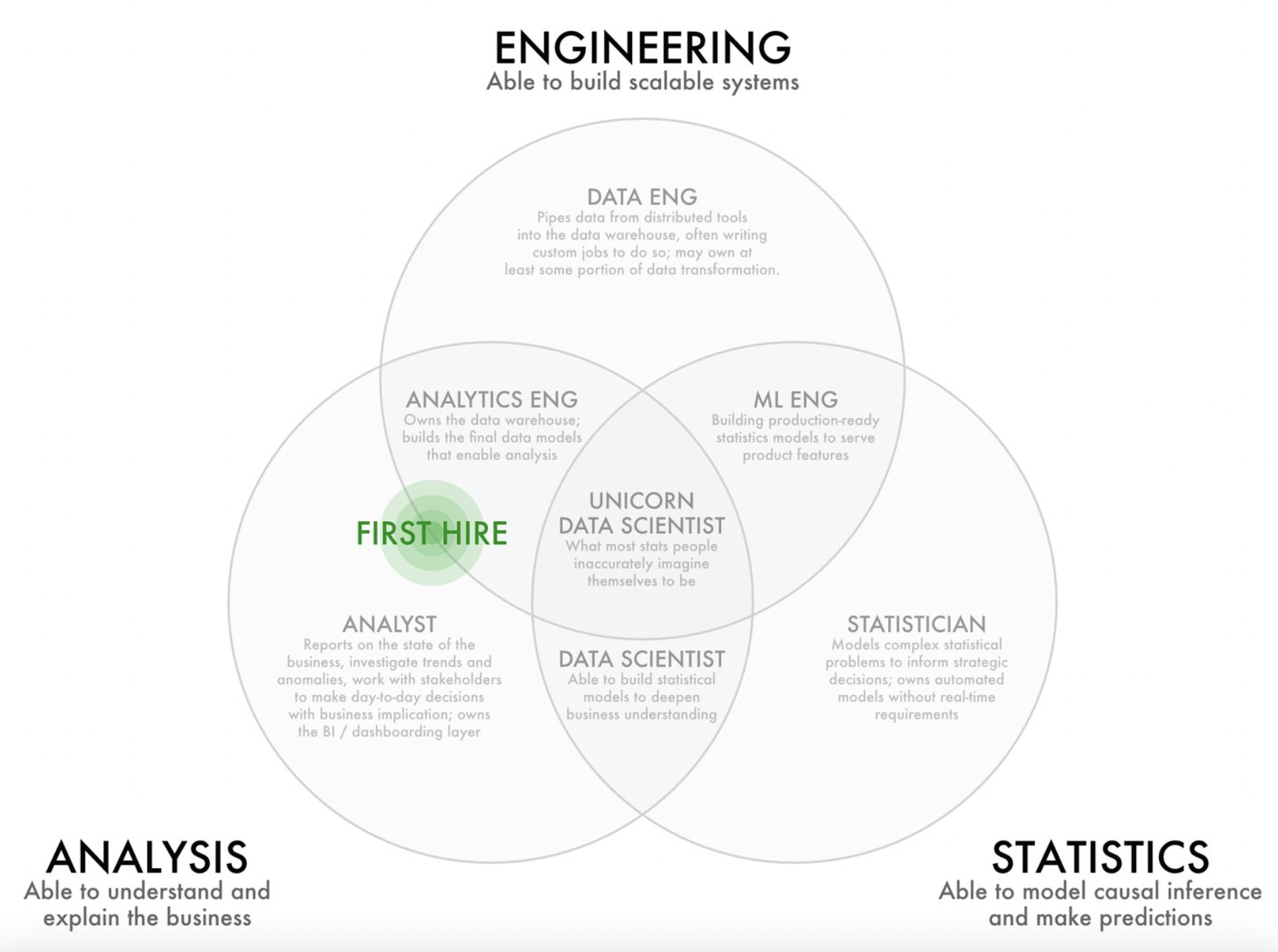
Source: abartholomew.com
What skills should your first data analyst hire have?
To effectively perform “analysis + analytics engineering” responsibilities, your first data analyst hire needs the following skills:
- Business understanding. This is a no-brainer. The person needs to understand what the business is about, including its goals and KPIs. This is the only way to know what insights are valuable.
- Data modeling. Data modeling sets data standards for the organization. So, the person needs to know how to create data models that clearly show the organization’s relevant data elements and the connections between them. The person should be able to create visual representations of what data will be captured, how it will be stored, and how the individual data elements relate to the various business processes.
- Knowledge of SQL. Structured Query Language (SQL) is the standard querying language for all relational databases (like Oracle, Microsoft SQL, MySQL, etc.). To extract data from these databases, you need knowledge of SQL. Thus, SQL is a minimum requirement for data analysts.
- Use of data ingestion tools. As a data analyst, you’ll need to transport data from different sources to a target site for evaluation and analysis. Data ingestion tools facilitate this by manually eliminating the need to code individual data pipelines for every data source. So, your first data analyst hire should be comfortable with using data ingestion tools or should be able to learn how to use them quickly.
How senior should your first data analyst hire be
As mentioned before, your first data analyst hire would perform analytics engineering responsibilities. Also, the person should be someone that will eventually lead your team of analytics professionals.
So, this should not be a starter analyst with minimal experience. Instead, they should be senior analysts with solid expertise in laying the foundations of a data warehouse and building and leading a data analytics team.
Someone with that profile should have more than the minimum bachelor’s degree and have at least four years of experience.
Data Analyst hiring process decrypted
Attracting the right people is usually a challenge when you need to fill a position. It is even more challenging if the job is technical like that of a data analyst.
Below we decrypt the process and show you how to get the right data analyst. This will be discussed under three subheadings:
- How to structure your analyst job description
- What to do beyond the sharing the job offer
- How to interview data analyst candidates
Structure your data analyst job description
Attracting strong data analyst candidates starts with posting a strong job description. Essential elements of a strong data analyst job description are:
- Background of the role
- Requirements for the role
- Responsibilities of the role
- Hiring Process
- 30/ 60/ 90 day plan
1. Background/ Overview
In this part of the “job description,” briefly state your organization’s business and your goals for the role you are filling. The overview is what sells your organization to the candidates.
An excellent example of an overview is:
[Name of the company] is a company that specializes in the creation of multi-discipline business platforms with specialist partnerships for value co-creation in each of the different business segments through modern co-petition business principles.
2. Requirements for the role
This is where you list the hard and soft skills you need in a candidate. It should include desired educational qualifications, certifications, and technical skills.
A good example is:
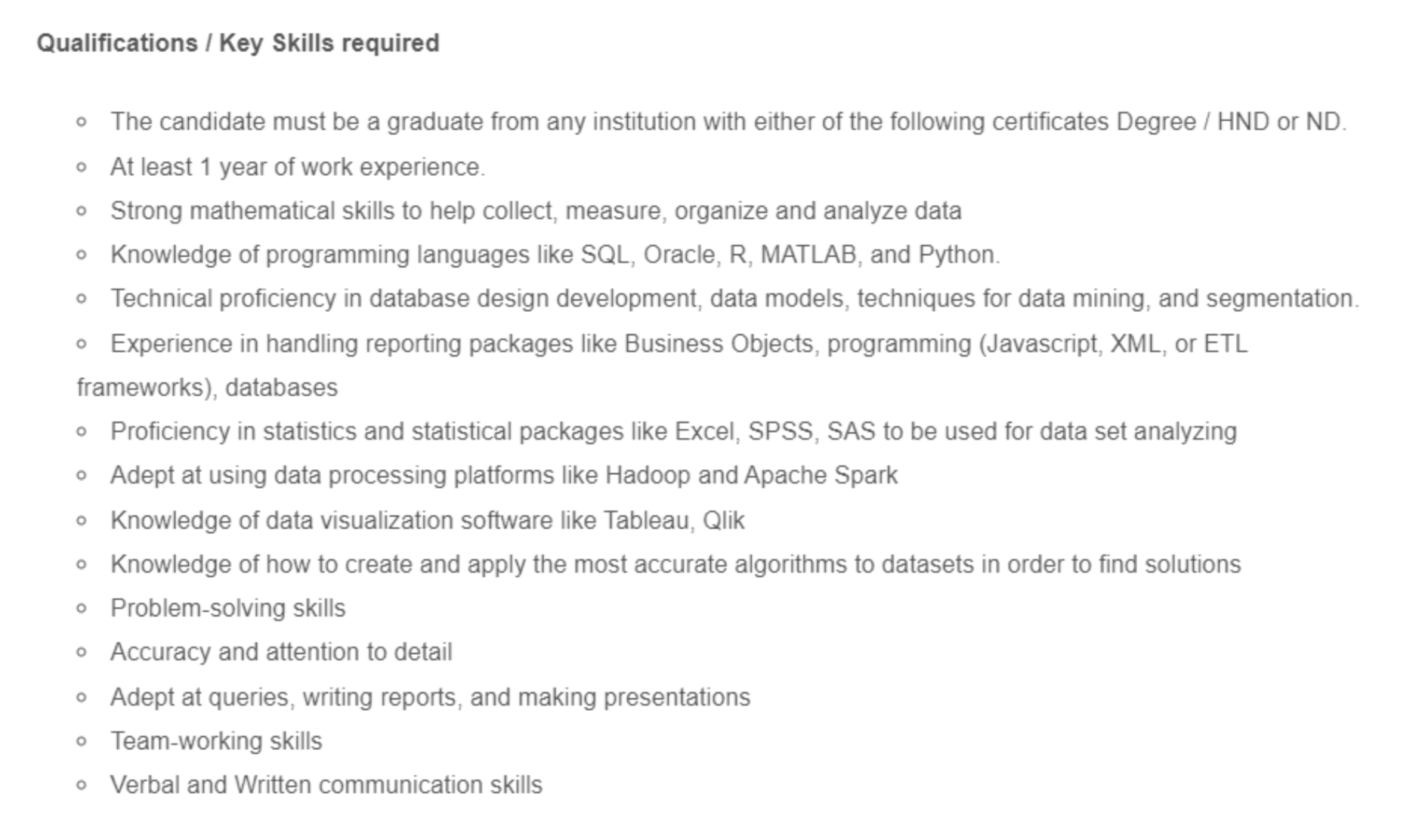
Source: Indeed
3. Responsibilities of the role
Here, state what you expect the data analyst to do in the role. While it is impossible to cover everything, you should be as specific as possible.
A good example is:

Source: Getdbt
4. Hiring Process
Mention the different stages in your hiring process, from submitting applications to the interview (and beyond, if applicable). Mention what each step will involve and how long it’ll take. Candidates usually appreciate this because no one likes to be kept in the dark.
An example of this is:
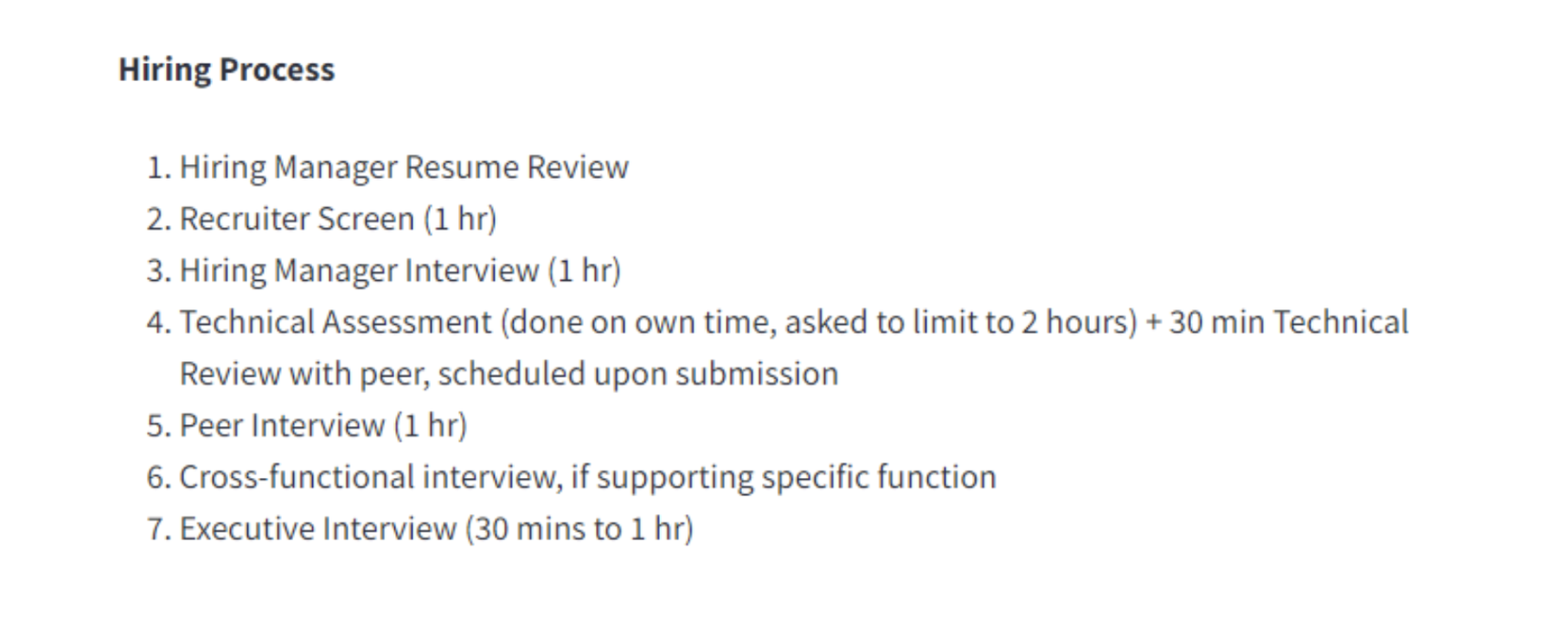
Source: Getdbt
5. 30/ 60/ 90 day plan
This means clearly stating your expectations of the person in 30, 60, and 90 days on the job. It helps set standards for performance.
An example of this is:

Source: Getdbt
Sharing the best job offer is not enough
While creating a great job offer is essential to attracting talents, even the best job offer does not guarantee to get the best talents.
This is because posted job offers are usually open to every Tom, Dick, and Harry. This is not that the Toms, Harrys, or Dicks will not make good analysts. It simply means that narrowing the search often produces better results.
Here are a few tips to go further in your research and find the best data analysts where they are 🙂
1. Visit data analysts’ communities
In the modern era, people with similar interests form communities to curate and share content. Interestingly, there are different data analyst communities. Simply reaching out to these communities can enliven your search.
Some popular online data analyst communities are:
- Kaggle – a data science and machine learning community.

Source: Kaggle
- StackOverflow – a question and answer online platform for data scientists, system admins, mobile developers, game developers, and more.
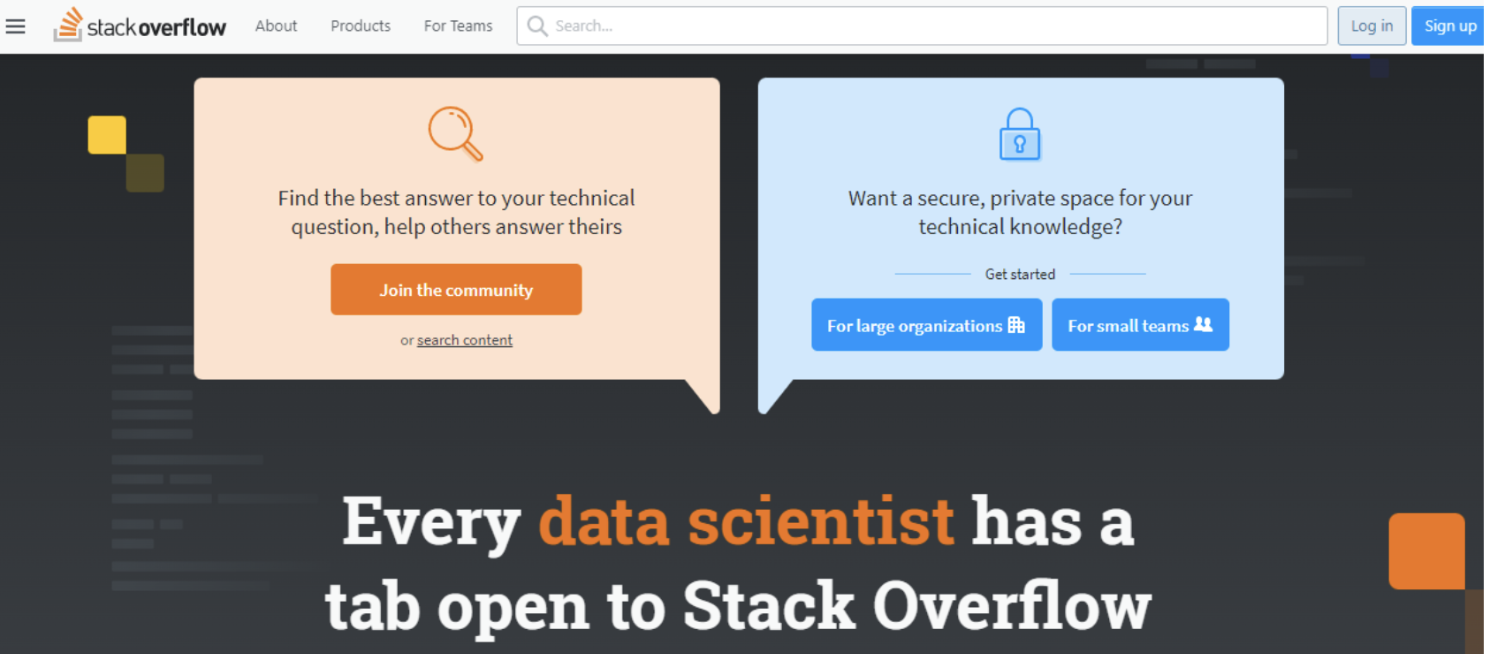
Source: Stackoverflow
Interestingly, data analyst communities are not only virtual. In addition to the online forums, they often hold offline meetups. Attending one of these seminars could get you “your man.”
2. Look at projects
A good data analyst resume does not make one a good data analyst. The only way to tell that someone has the technical competencies mentioned in their resume is to evaluate projects that person has done.
Thankfully, you do not need to visit the person’s previous employer for this. There are many public resources that data analysts can use to showcase projects. An example is Kaggle.
There are different Kaggle competitions where analysts are tasked with solving data science problems. Host a Kaggle competition and see what the various data analysts do.
3. Look for storytellers
Storytelling means showing how insights from data relate to people and scenarios and galvanizing support for particular recommendations.
It is crucial because data analysts do not only munch numbers but they interpret data to inform decisions. Unfortunately, sometimes even the best facts do not sway people. Instead, you need to connect with people’s emotions to get their buy-in.
Conduct an interview for data analyst candidates
When conducting interviews for data analyst candidates, ask questions that reveal the person’s hard skills, behavioral skills, and soft skills.
1. Hard skills
Hard skills refer to the technical knowledge and abilities of the candidate. Relevant questions to reveal the technical abilities of data analysts candidates include:
What statistical tools and database software have you used previously, which do you prefer and why?
Why this matters:
Data analysts will apply statistical analysis to data. You need to know that they can do this.
What to listen for:
- Knowledge of the main data language SQL
- Use of other analysis software like SPSS
- A willingness to learn new software
2. Behavioral skills
Behavioral questions show how the candidates handled situations in the past. An excellent example of a behavioral question to ask a data analyst candidate is:
Describe a time when you designed an experiment. How did you measure success?
Why this matters:
Data analysts conduct experiments to determine whether an action will be successful, thereby saving their organizations from taking doomed steps. This question tells you if the candidate understands the concept of experiments.
What to look out for:
- Outlining clear objectives of the experiment
- Ability to design metrics and use these to measure results
3. Soft Skills
Soft skills refer to the candidate’s personality traits. An example of an excellent question to ask data analyst candidates to reveal personal traits is:
What do you think are three personality traits that data analysts should have, and why?
Why this matters:
Data analysts need more than technical abilities. In answering this question, candidates will often mention attributes that they possess. So, the question tells you more about the person.
What to look out for:
- Appreciating that certain personality traits are as crucial to a data analyst as technical skills
- A mention of some of the most critical soft skills, like attention to detail.
How to get the best of your first data analyst
Hiring the right data analyst is good, but it is even better if the person delivers well.
One way to do this is to set clear expectations using the 30/ 60/ 90 days plan. That is, clearly define what you expect the data analyst to be doing (or have done) after 30, 60, and 90 days on the job. Then review these with the data analyst periodically to determine how performance is stacking up.
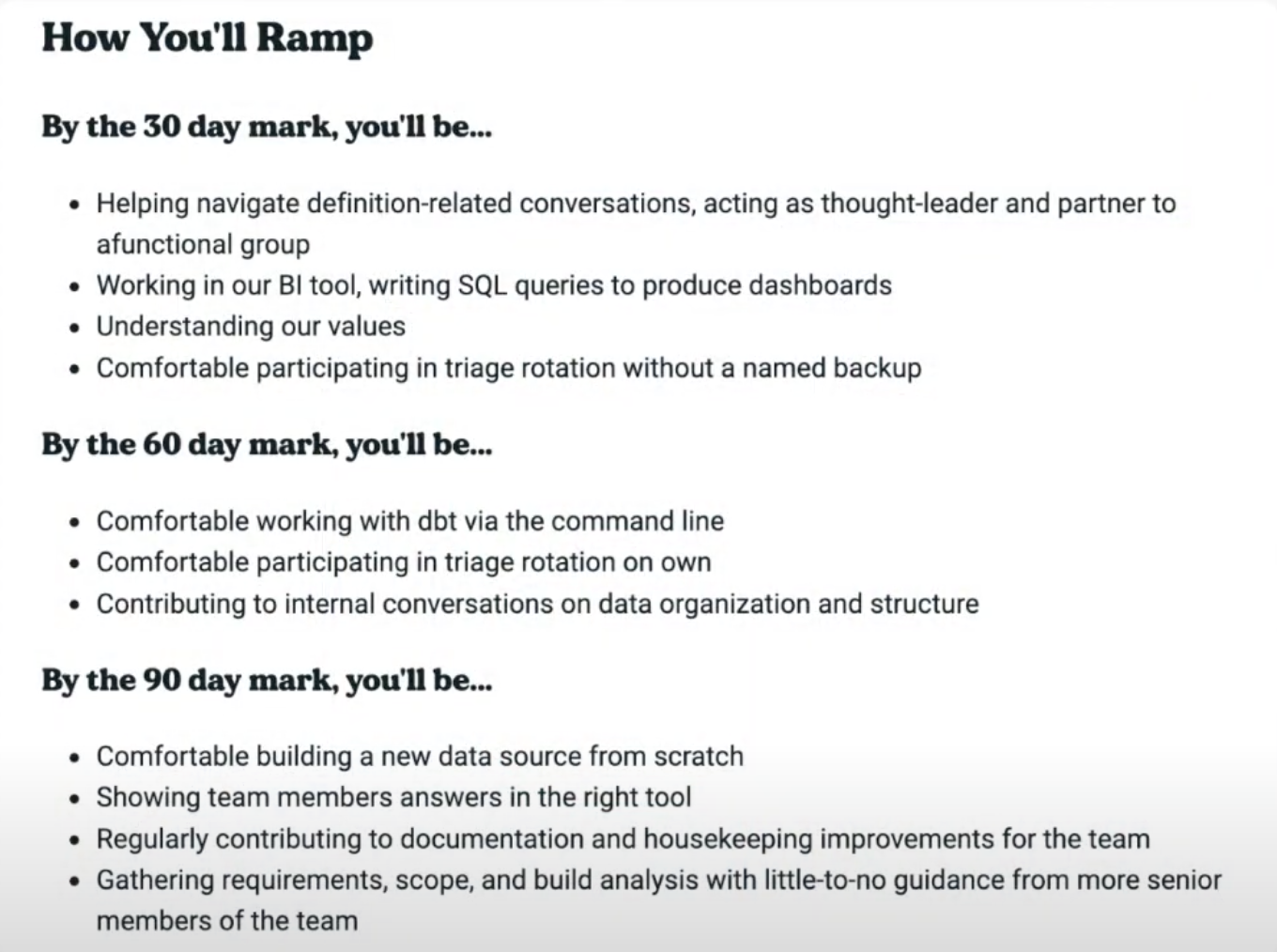
Source: Getdbt
30 days expectations
Since the first 30 days is still “early days” for the data analyst in the organization, expectations should center around:
- Familiarization with the company’s business and values
- Understanding reporting and insight needs
- Extracting data from different sources and loading it into the data warehouse
60 days expectations
By the end of the second month in the role, the data analyst should have understood the business. So the analyst should have:
- Have created dashboards covering important KPIs.
- Be in the process of developing a data model.
90 days expectations
By the end of the third month, the data analyst should be very mature in the role. The analyst should:
- Have completed the first version of the data model.
- Be able to build a data source from scratch and easily build analysis.
- Be able to answer questions for business users easily.
Wrapping up
You need a data analyst to make sense of your business data and give you insights that’ll help you make the right business decisions. Key takeaways from this detailed article about “how to hire a data analyst” are:
- You may not need an analyst until you have 20 – 50 employees and have data needs that justify building data infrastructure.
- Your first data analyst hire should not be a junior analyst but a senior with expertise in building infrastructure and leading teams.
- To attract strong data analysts, important elements to include in the job posting consist of the “hiring process” and “30/ 60/ 90 days” plan.
- Posting a good job offer does not guarantee to get the right analyst. You need to narrow your search by visiting data analyst communities and evaluating projects.
- In interviews for data analyst candidates, ask questions that reveal hard skills, soft skills, and behavioral elements.
- After hiring, to get the best out of your data analyst, use the “30/ 60/ 90 days” plan to set clear expectations.


